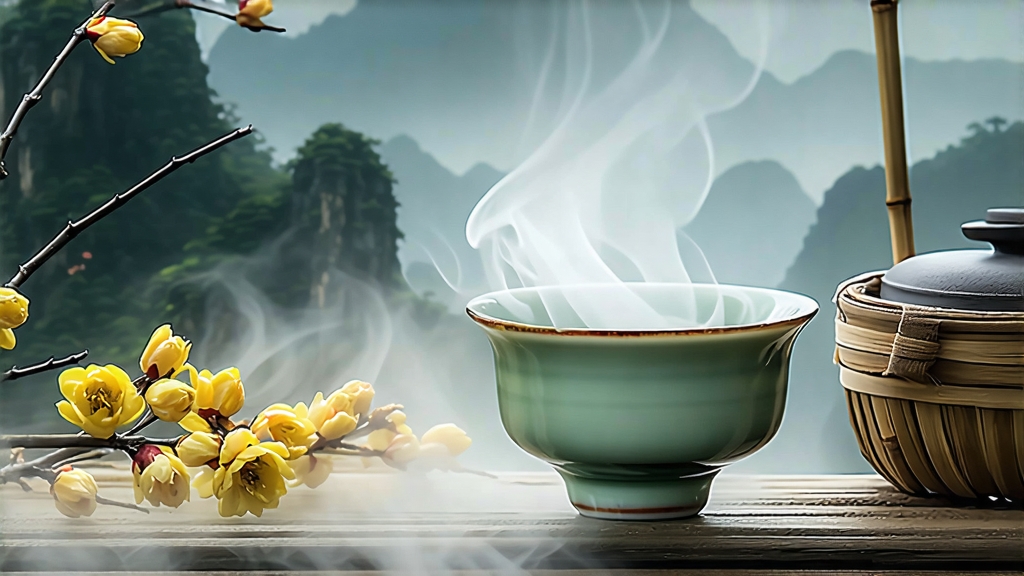
High on the northern shoulder of the sacred Meng Ding mountain, where Sichuan’s clouds brush the evergreen crowns at 1 450 m, a tea once reserved for Tang-dynasty emperors still unfurls its single-bud pluck every early April. Locals call it Huang Ya—“yellow bud”—yet the name hardly prepares newcomers for the liqueur that glows like polished topaz or for the scent that drifts between fresh corn silk and distant orchards after rain. Meng Ding Huang Ya is the least-travelled celebrity of China’s six-colour tea family, a variety whose production once vanished for almost three centuries and whose flavour can still vanish from the palate like a half-remembered poem. This essay invites the international reader to walk the narrow stone steps of Meng Ding, to witness the moment when green leaf is coaxed into “yellow,” and to master the quiet ritual that releases its gentle, enduring sweetness.
-
A leaf born of poetry and politics
Meng Ding mountain has been a cultural summit since the Han dynasty; the Daoist sage Gan Shi is said to have brewed herbs here in 53 BCE. By the Tang (618-907 CE) the court fixed a yearly quota of “mengding shihua” (stone-flower) as imperial tribute, and Song emperor Huizong—himself a skilled tea aesthete—declared Meng Ding teas one of the two indispensable gifts to the throne. Huang Ya emerged later, probably during the Ming, when tea masters began experimenting with a slow, humid “sealed yellowing” step after killing-green. The technique muted grassy astringency, yielding a cup soft enough for the palace ladies yet layered enough for scholar-officials who composed verses beside stone lanterns. When Qing tax reforms shifted tribute to cheaper lowland gardens, Huang Ya’s intricate craft disappeared from written record; only a few monks in the Yongxing temple kept seed-bearing bushes alive. The recipe was not fully reconstructed until 1959, when a Sichuan delegation of agronomists and monks compared fragmentary Tang scrolls with grandmother memories. Today fewer than 120 families produce authentic Meng Ding Huang Ya, and the entire annual yield would fill barely half a freight container—reason enough for it to remain a whisper rather than a shout on world menus. -
Microclimate and cultivar
The mountain’s spine traps perennial mist, shortening sunlight to 900 hours a year and forcing the tea bush to synthesize more theanine and less catechin. Night temperatures drop 10 °C, locking floral lactones inside the bud. The local micro-cultivar, “Meng Ding #9,” carries tiny serrated leaves the size of a sparrow’s tongue, each covered in such dense pubescence that early pluckers called them “snow eyebrows.” Only the standard of one bud or one bud-with-unopened-leaf is accepted; anything larger is redirected to humbler green-tea lines. Picking begins at dawn when dew still weighs 6 % of the leaf mass, a moisture level later judged critical for uniform yellowing. -
The craft: seven steps, three nights of fear
Step 1: Withering on reed racks for 70 minutes softens cell walls without sun exposure, preserving pale colour.
Step 2: Pan-firing at 160 °C for 4 minutes deactivates polyphenol oxidase but stops short of the nutty notes sought in Longjing.
Step 3: Initial rolling—no pressure, just a wrist-flicking motion—breaks cuticle wax so that aromatic precursors mingle.
Step 4: The signature “sealed yellowing” (men huang) wraps 3 kg of warm leaves in double-layered cotton bags, then slides them into a bamboo steam chest kept at 32 °C and 78 % humidity. Every two hours the pile is gently turned so that peripheral leaves do not ferment faster than the core. This lasts 48–60 hours, during which chlorophyll degrades to pheophytin and a faint maillard sweetness emerges. Masters listen for a rustle that sounds like “walking on fresh snow”—a sign that leaf surfaces are drying while interiors remain viscous. One missed timing and the lot slips into sour compost; hence the saying “three nights of fear.”
Step 5: Low-temperature pan-drying at 80 °C for 20 minutes sets the yellow colour.
Step 6: Final rolling under 0.8 kg/cm² pressure creates the